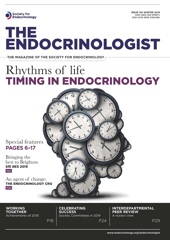Puberty is the key developmental stage of transition from childhood to adult life, with the achievement of adult height and body proportions, the development of external sexual characteristics and the capacity to reproduce.
In some children, puberty may take place prematurely to produce precocious puberty, whilst, in others, it fails to be switched on at the appropriate time, leading to delayed puberty. The mechanisms behind these pubertal timing abnormalities are varied, and many remain incompletely understood.
THE PROCESS OF PUBERTY
Central to the process of puberty, and heralding its onset, is upregulation of pulsatile gonadotrophin-releasing hormone (GnRH) secretion from the hypothalamus. This, in turn, results in increased luteinising hormone (LH) and follicle-stimulating hormone release from the anterior pituitary, which promotes gonadal maturation, gametogenesis and sex steroid and peptide hormone production.
The hypothalamic-pituitary-gonadal (HPG) axis is active at three main developmental stages. The axis develops during fetal life, is reactivated in the postnatal period during ‘mini-puberty’, and then stays quiescent from 2 years of age until around 8–9 years, with minimally detectable LH concentrations. At puberty, a co-ordinated array of signals allows the reactivation of the axis after this mid-childhood period of dormancy. It is still unclear which primary mechanisms suppress the axis after mini-puberty and allow the release of this ‘puberty brake’ at the end of mid-childhood.1
A SPECTRUM OF TIMING
There is a spectrum of pubertal timing in the general population, with a mean onset of Tanner genital stage 2 (G2) at 11.5 years in boys and Tanner breast stage 2 (B2) at 11 years in girls (Figure). Whilst the norms for pubertal onset do vary between ethnic groups, the age limits observed for G2 in boys are 9–14 years, and for B2 in girls are 8–13 years.
However, the timing of puberty in most countries in the developed world exhibited a shift to earlier onset in the first half of the 20th century, most notably in girls.2 More recently, there has been an increasing trend towards an earlier age at pubertal onset (B2 or G2), but also towards a larger number of children completing their puberty at a later age.3
FACTORS INVOLVED
Nutritional status, adoption, geographical migration and emotional well-being all have an effect on pubertal timing. Nutritional changes clearly have a key role, as shown by the positive correlation between age at puberty onset and childhood body size, particularly in girls. These trends are less apparent in boys.4
The relationship between fat mass and puberty is mediated, at least in part, through the permissive actions of leptin, a key regulator of body mass which is produced from white adipose tissue. However, ghrelin, neuropeptide Y and many other signalling pathways are likely to be important in the nutritional control of pubertal timing.
The effect of possible endocrine-disrupting chemicals (EDCs) on the timing of puberty has also been an ongoing concern.5 Many compounds, including polybrominated biphenyls, bisphenol A, herbicides and phthalates, have been implicated as potential EDCs, responsible for contributing to this observed trend.
Despite the importance of environmental factors, a genetic influence on the timing of puberty is fundamental. Although the timing of pubertal onset varies within and between different populations, it is a highly heritable trait, as shown by the high correlation of the timing of sexual maturation within families and in twin studies. Previous epidemiological studies and genetic approaches estimate that 50–80% of the variation in pubertal onset is under genetic control.6 Despite this strong heritability, little is known about the control mechanisms.
UNDERSTANDING GENETIC CONTROL
Attempts to identify key genetic regulators have ranged from genome-wide association studies of age-at-menarche, examining pubertal timing in healthy women, to next generation sequencing approaches to identify causal mutations in disease cohorts with delayed, absent or precocious puberty. The existence of genetic heterogeneity is supported by several large genome-wide association studies, with nearly 400 loci associated with timing of menarche to date, explaining approximately 7.4% of the population variance.7
Advances in our understanding of the genetic control of the HPG axis via mono- and digenic pubertal disorders have come both from patients with late or absent puberty (cohorts of isolated pubertal delay or hypogonadotrophic hypogonadism), and also from familial central precocious puberty (CPP).
Mutations in the pubertal brake gene MKRN3,8 and more rarely in the kisspeptin gene KISS1 and DLK1, highlight the importance of upstream control of GnRH secretion in the pathogenesis of CPP. In delayed or absent puberty, more than 40 genes have been identified, mutation of which causes or contributes to the aetiology of these conditions. Many of these are specific to isolated delayed puberty, syndromic pubertal delay or hypogonadotrophic hypogonadism.1
These genetic causes demonstrate that defects in GnRH neuronal development, GnRH secretion, upstream control or downstream action may all cause disorders of pubertal timing.
CLINICAL IMPACT
Disturbances of puberty encompass an important group of pathologies within the field of paediatric endocrinology, affecting over 4% of adolescents. In addition, abnormal timing of pubertal development is associated with adverse health and psychosocial outcomes. This is not only important to the individual, but also has a potential major impact on public health, especially in view of the secular trend towards an earlier age of puberty onset.
Early puberty, in particular, is associated with adverse health outcomes, including breast and endometrial cancer, obesity, type 2 diabetes, cardiovascular disease, short stature and even increased mortality. Until recently, it had not been clearly shown that late pubertal timing is also associated with adverse health outcomes, but data from the UK Biobank study from both genders have demonstrated that delayed puberty also has profound impacts on health in later life.9
The considerable progress in understanding the mechanisms which control puberty over the last 10 years has been a success story for basic research in neuroendocrinology, but has also been translated into clinical practice to allow a better understanding of the mechanisms of disordered pubertal development and, in some cases, to enable diagnostic genetic testing and counselling.
Sasha Howard, NIHR Academic Clinical Lecturer in Paediatric Endocrinology, Centre for Endocrinology, William Harvey Research Institute, Barts and the London School of Medicine and Dentistry, Queen Mary University of London
REFERENCES
- Howard SR & Dunkel L 2019 Endocrine Reviews 40 1285–1317.
- Parent AS et al. 2003 Endocrine Reviews 24 668–693.
- Parent AS et al. 2015 Frontiers in Neuroendocrinology 38 12–36.
- Sorensen K et al. 2010 Journal of Clinical Endocrinology & Metabolism 95 263–270.
- Mouritsen A et al. 2010 International Journal of Andrology 33 346–359.
- Morris DH et al. 2011 Paediatric & Perinatal Epidemiology 25 306–311.
- Day FR et al. 2017 Nature Genetics 49 834–841.
- Simon D et al. 2016 European Journal of Endocrinology 174 1–8.
- Day FR et al. 2015 Scientific Reports 5 11208.






